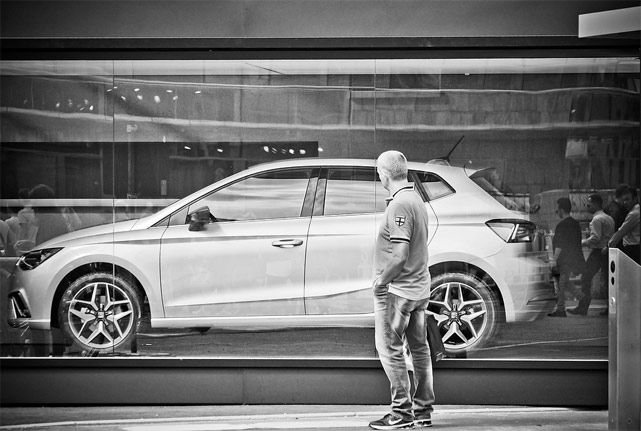Experoence of West
According to research of McKinsey, auto trade rapidly goes online, about 500’000 of vehicles every year for sale on eBay. One of the largest European online car market AutoScout24 registers more than 300 million visits per month. At the same time, 85% of customers still use the dealer showrooms to buy the car and searching for the necessary information, but 1 from 4 buyers remain dissatisfied with the dealer and the process of purchase. The average number of visits to dealers before making a final decision on buying a car fell from 5 to 1 (depending on the brand and the region). More than a third of potential buyers willing to consider buying online, but not less than 80% of buyers claim they need to take a test drive for purchase. Almost 90% of buyers use websites of the dealer or the manufacturer at the early stages of decision making.
Such changes in consumer behavior require making appropriate changes in the management of sales. The growing popularity of mobile apps and social networks are changing patterns of interaction and communication, and, as a result, client’s behavior. Digitalization makes changes to the sales process and service, and market are forced to to innovate in their retail formats.
The McKinsey Study «Retail Innovation Consumer Survey» showed, that about 80% of new vehicles’ buyers and almost 100% of used vehicles start buy car search on the Internet, which means the dealers fail as the main source of information and loose influence the client. The role of the Internet becomes even more important among consumers aged 18 to 34 years. Nearly 90% of these customers use a range of sources: manufacturers ‘ websites, dealers website, social media, blogs and forums, to gather information and compare offers. Thus, the decision to purchase is being rapidly replaced by online.
Consequently, fewer visits to the dealer are needed. manufacturers and dealers are forced to optimize their online presence, in particular, integrating content from third-party sites (consumer reports and others).
Thus, clients are becoming more informed and demanding, they expect from dealers not only knowledge of the latest models and specifications, but the possession of information about new applications and connectivity to such devices, as smartphones and tablet computers. As a result, more and more manufacturers are starting to upgrade their retail stores, trying new retail formats, such as boutique stores in luxury locations (Tesla Stores, Audi City Cyberstores, BMW i Stores, Mercedes-Benz Visionary Stores), online stores and others. Existing dealerships, manufacturers strive to provide the latest 3D technologies and video screens. They also hire the staff of experts and consultants, who can answer questions through interactive data applications on the iPad. For example, Ауди opened Audi City – kiberlain, multitouch tables for model configurations are used, as well as video screens to display special models, and lounge areas for counselling in a private setting. But such projects has not yet received mass dissemination.
Dealerships remain a significant point of contact with the customer, but they have fewer chances to influence the decision, as potential buyers become familiar with a lot of information before coming to the showroom.
Buyers use offline sources of information (the advice of friends and colleagues) and online resources (in particular, sites of dealers) at the stage of collecting information and making decisions. According to the McKinsey study, the buyer before making a decision to purchase on average 2-3 uses of the information source (for example, brochure, test drive, advice). In this case, only the dealer can provide after-sales service and to form loyal customer for subsequent purchase.
Thus, despite the development of online trade, manufacturers understand the importance of dealer showrooms and, as a result, will be forced to provide more guidance based on processing data obtained from different sources, so that dealers can optimally adapt to changing conditions and to increase the level of service. In this case, the array of customer data will be compiled from multiple fields, including the field of online: existing databases of dealers and manufacturers, “social” data obtained from the online space, and data received from a connected in-car devices.
Source of information: http://www.mckinsey.com
Russian experience
Intelligence interviews with representatives of St. Petersburg dealer centres showed that the significance of the dealership is still in first place in the process of making a purchasing decision. It is so not only because the dealers are expert opinion carriers whom cient trust and can answer questions and help to overcome doubts, but also because the Russian buyers can not imagine the car buying process without visual evaluation of the appearance and passing of a test drive for “trying on” advertised comfort.
At the same time, the average period of car ownership in Russia is 3-5 years. Most often the reason for the change of the vehicle becomes increased operating costs associated with increasing need for small and large repairs. Another significant reason is the change of needs, for example, due to changes in marital status, or the desire to own the machine, enhancing the social status of its owner.
In the process of determining the needs of the dealers also tend to help the client’s choice between sedan and hatchback, underlining, the sedans are often chosen based on the characteristics of comfort, versatility, availability of electronics and any necessary devices, while the hatchback, mainly chosen for security reasons.
Summarizing, we can say that the experience with the dealer, as for European customers and Russian remains a key factor in the formation of loyalty that affect the long-term relationship, as a competitive buyer, and with representatives of its social environment, which services of the dealership may be recommended.





